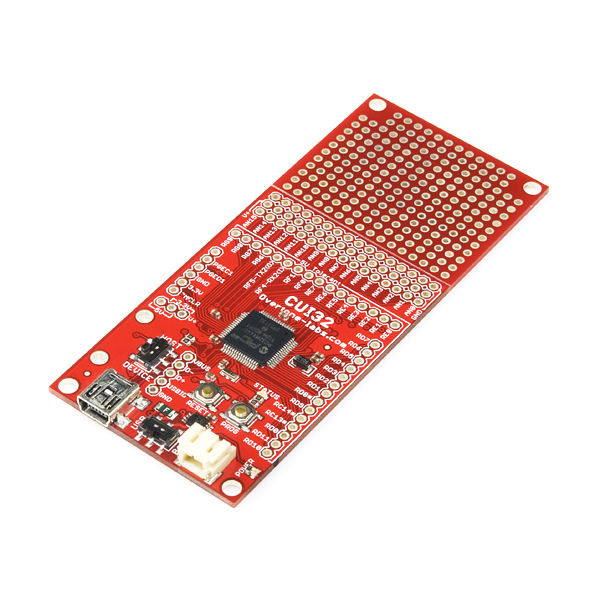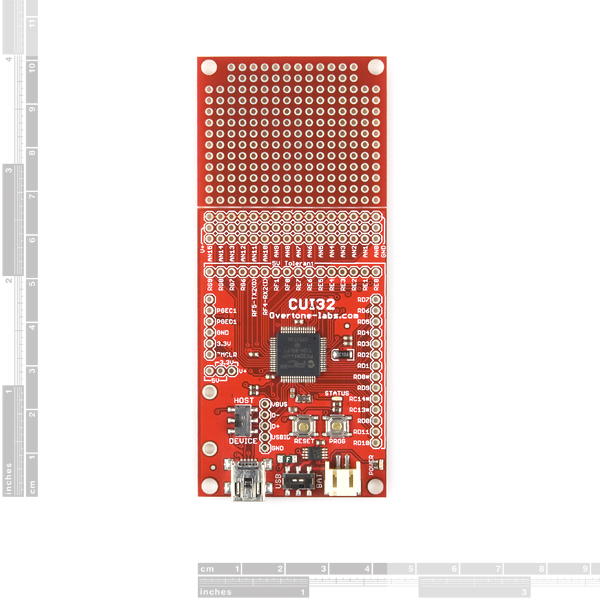CUI32 PIC32MX Development Stick
Replacement: None. We are no longer carrying this board but check out our other PIC development tools. This page is for reference only.
The CUI32 is a new version of the CREATE USB Interface, based on a 32-bit PIC. The CUI32 ships with "StickOS" installed as its default firmware - this is a full operating system (!) created by Rich Testardi with an on-board BASIC compiler, line editor, debugger, profiler, and simple file system to create new firmware programs and run them, without having to install any software on your host computer... All that's needed is a standard terminal emulator (Hyperterminal/Teraterm on windows, the "screen" command in the OS X terminal, etc.)! [
StickOS](http://www.cpustick.com/) is a very elegant approach for beginners, and also works great as a quick prototyping environment for advanced users - see a couple of examples (using a different microcontroller) here.
The CUI32 also ships with a standard bootloader pre-installed (in addition to StickOS), so you don't need a PIC programmer to write your own C programs either! All of Microchip's own examples from their USB framework can be compiled for the CUI32, and while these are more complex than a BASIC program written in StickOS, the CUI32 homepage and the Google Code wiki will allow anyone to share examples that are set up specifically for the CUI32.
Finally, since the CUI32 uses the same family of PIC32s (the PIC32MX440F512) as the UBW32 board, it is compatible with a lot of the resources that have been developed in this open source project as well, such as this host application for bootloading the board from OS X.
Note: This product is a collaboration and a portion of each sale goes toward the designer for product support and continued development.
- 4.0 x 1.7" (2.6 x 1.7 without prototyping area)
CUI32 PIC32MX Development Stick Product Help and Resources
Comments
Looking for answers to technical questions?
We welcome your comments and suggestions below. However, if you are looking for solutions to technical questions please see our Technical Assistance page.
Customer Reviews
No reviews yet.




Update: The Eagle files have just been uploaded to the Google Code Repository.
This board is awesome,
BUT: If you put a ICSP plug on this board, the PICkit3 pod faces AWAY from the board (or if the plug is bent 90 degrees to the board the PICkit3 connects with the LED's facing downwards.)
I didn't do that and my green heartbeat LED no longer blinks...
Maybe I can fix that later but right now I am going to try a MAX32 board for 10 bucks more (Digilent).
IF Sparkfun would carry the Digilent boards I WOULD buy one
from here.
Wow!
Look at the response this little board (and CUI in general) is getting on the web. Lots of hits!
I don't work for SparkFun (wish I did :-), but I AM getting one of these CUI32's for myself. I am also getting a PICkit3. (Not necessary to have, but great if I need to restore StickOS or do some C programming.)
(I like my Arduino, but if I had seen this at the same time I got it would have been a VERY hard choice.)
If I solder "header pins" to the 6 pin ICSP port (the 6 solder holes on left side, as is the USB port) and properly connect a
PICKit3 module there, I should be able to use the MPLAB IDE to
program/debug the CUI32 in C32/Assembly. Correct?
It sort of defeats the purpose of StickOS, but I want to try and run FreeRTOS and other things on the board after I try StickOS Basic (I can always restore the StickOS if need to.)
Anything I need to be cautious of?
Thanks in advance!
Not sure if this is printed somewhere else, but could you guys supply the following? Thank you.
1) RAM and Flash left for user-code? (when using StickOS)
2) Number of I/O pins on board?
3) How many (if any) interrupt inputs?
4) How many PWM outputs?
some of the info you are looking for can be found here:
http://code.google.com/p/cui32/
(together with a much better picture)
It would be nice to have a USB A connector on the board along with Ethernet
@all beware !
in "PIC32MX3XX/4XX Family Data Sheet", page 13
The pins RC13 and RC14 are the secondary clock(SOSCI/SOSCO) and are not marked as 5V tolerant. (Even if it's under the 5V "silk" )
On cui32 they are near the prog button....
Thus the asterisk, which says "Not 5V Tolerant" on the bottom silk screen.
Hi,
is this board open-source/open-hardware? Dan Overholt mentioned it back on http://overtone-labs.ning.com/profiles/blogs/first-project-of-overtone-labs
"The board will be all open source, [...]"
For example will the Eagle files be made available, or are they owned by SparkFun?